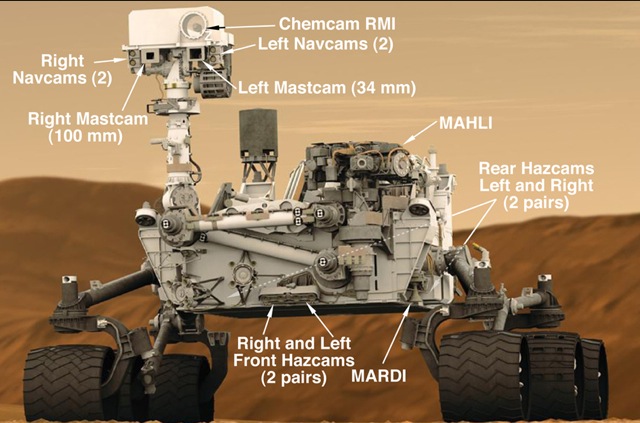We look at Curiosity’s safe landing, and what to expect as it is activated. Curiosity woke up at about 5:45pm Pacific Time Monday (morning for the rover), on very flat terrain, with no obstacles visible. Even though the vehicle hasn’t been fully checked out yet, images and video are now beginning to rain back down to Earth. (At last check, NASA’s live video streams were still being hammered). If you’re wondering what it’s all about, here’s a quick rundown on Curiosity, its many cameras, its instrumentation, and JPL’s initial activity list.

The mission. Curiosity’s primary mission is to determine whether Mars has, or has ever had, an environment capable of supporting life. NASA’s search for life on the other planets of the solar system has largely shifted from looking for direct evidence to looking for habitability first—is the environment conducive to life and are any of the raw materials present? By studying the rocks and soil of the area around the landing site, the spacecraft can provide some answers to those questions.
Curiosity has a lot of cameras—17 to be exact:
• Four pairs are redundant front and rear “hazcams” to help deal with navigational hazards as they arise. The first two images sent back were hazcam pictures taken before the dust covers were removed.
• Two pairs are left and right redundant Navcams, black and white cameras set up to give stereo imaging with a 45-degree field of view.
• The left and right MastCams can take true color 1600×1200 images, or 720p video at 10 frames per second. The left camera has a 34mm focal length, which gives a 15-degree field of view. The right camera has a 100mm focal length, which yields a 5.1-degree field of view. Neither camera has a zoom lens, but both have autofocus.
• The Mars Hand Lens Imager (MAHLI) is mounted on a robotic arm and is so named because it’s mounted on a boom and can be used like a geologist’s hand lens to look closely at samples. The MAHLI camera can resolve objects down to 14.5µm per pixel. It does have zoom, and its focal length can vary from 18.3 to 21.3 mm, with a 33.8- to 38.5-degree field of view. MAHLI is also equipped with its own LED illumination, including ultraviolet LEDs to check for fluorescence.
• The Mars Descent Imager (MARDI) took 1600×1200 color images at about 5 frames/second. It started at about 3.7km altitude and continued all the way down to just before the skycrane began lowering the rover. It has a 70° by 55° field of view, which gave it about a 1.5m/pixel resolution when the descent stage got down to 2km. On the ground, its resolution is about 1.5mm/pixel, with about a 100x75cm field of view, but it will point straight down from about 70cm above the ground.
MARDI recorded video of Curiosity’s descent to Mars, which will allow mission planners to find out exactly where Curiosity landed. That video may prove crucial to future mission planning, and it should also be pretty dramatic.
The Chemistry and Camera complex (ChemCam) is really an entire suite of instruments. It includes a 1067nm infrared laser to use for laser-induced breakdown spectroscopy, targeting, and vaporizing rocks. It can then use a small micro-imager camera along with detectors to look simultaneously at the plasma in near-IR, visible, and UV ranges. ChemCam can resolve images down to 1mm at a 10m distance. In addition to the seventeen cameras, Curiosity has several other instruments:
• The Rover Environmental Monitoring Station (REMS) monitors humidity, pressure, temperatures, wind speeds, and ultraviolet radiation.
• The Alpha-particle X-ray Spectrometer (APXS) bombards samples with alpha particles and looks at the spectrum of X-rays emitted, yielding the elemental composition of the sample.
• The Chemistry and Mineralogy (CheMin) X-Ray diffraction and X-ray fluorescence instrument, another spectrometer, is aimed toward identification of minerals by mapping their crystalline structure. It bombards samples with X-rays and looks at the reflected patterns.
• The Radiation Assessment Detector (RAD) was turned on before Curiosity reached Mars and will continue to measure radiation on the surface. The RAD is specifically aimed at aiding planning for a future human mission.
• The Dynamic Albedo of Neutron (DAN) instrument was included to measure hydrogen on the Martian surface, which will yield a better measure of how much water and ice is present near Curiosity’s landing site.
How did it all work so well?
The Mars Science Laboratory was developed and built by a team from NASA’s Jet Propulsion Laboratory in Pasadena, with help from several contractors and investigators from other countries. The cameras and sensors were built by or with help from other NASA centers, Malin Space Science Systems, Russia, Canada, Finland, and Spain.
At first blush, MSL looked to many as if it was far too complex to possibly succeed, but it’s beginning to look like the Seven Minutes of Terror video may have been a masterful case of NASA managing the public’s unreasonable expectations. NASA’s internal prediction of a successful landing was about 98 percent, a number given by its simulations.
That’s not to say that the MSL team doesn’t deserve every gram of credit they can get; there’s nothing remotely easy about landing a spacecraft on a planet 330 million kilometers away. Their response to the successful landing showed how much they had invested in the rover’s success.
But throughout most of the mission, Curiosity was actually repeating a relatively tried-and-true mission profile: enter with an aeroshell, slow with a supersonic parachute, slow more with rocket power. The only portion of the descent that was unconventional—and it was completely unconventional—was the “skycrane” at the end.
The “skycrane” technique turned out to be very successful. Just over a third of the total fuel remained in the descent stage as it sped away, giving rise to speculation that a future Mars mission could use a descent stage that acts as a science station after it drops its rover off, or one able to drop off multiple rovers. Curiosity has also demonstrated that a very large probe can be landed on the Martian surface, something that will be essential for any future mission to bring a sample back to Earth.
Beyond the skycrane, some of the reasons for the mission’s smooth start date back to the design and construction. Many of the parts for modern space probes are now “catalog parts.” The US aerospace industry has matured to the point where some parts are used on many spacecraft, and they can be found and ordered by weeding through catalogs. The pieces are very consistent performance-wise and they have been thoroughly tested. That means nobody is off inventing something new in a machine shop.
Perhaps most importantly, NASA JPL has also adopted very stringent software development standards with origins in the automotive industry. Basically, they limit common coding techniques that become too risky when lives or expensive spacecraft hang in the balance.
What happens now?
NASA JPL will spend the next two weeks checking out systems and deploying the cameras. After spending several years and 2.5 billion dollars, they don’t want to take any chances.
Color images and data will begin streaming in soon as cameras pass checkout and get activated. The Curiosity team will use them to figure out more exactly where the rover is. They’ll correlate images with radar data, and know where the vehicle is within centimeters. And they’ll then pick its first destination.
JPL has already begun sending lists of commands to the rover. Atop the list was the checkout and deployment of the High-Gain Antenna (HGA). Curiosity has, up until now, been using a relatively weak omnidirectional antenna that does not need to be pointed, but can only transmit data at very low speeds. The HGA will be crucial for transmitting the color video and volumes of data which are coming later. Although the HGA checkout is still in progress, really exciting data began arriving at just after midnight Tuesday morning: weather, radiation data, and camera images.
Many activities are waiting until the onboard software is replaced with a newer, more capable version, a process that will begin on Sol 5 (a sol is a day on Mars).
Already, though, scientists and non-scientists the world over are studying the images that have been sent back to Earth. The science has already begun.





